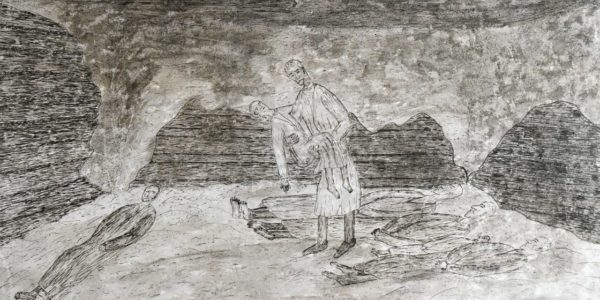Patrick van Schie
After having ruled the Soviet Union for more than a quarter of a century, Josef Stalin died seventy years ago, in the early morning of March 5, 1953. “The news of Comrade Stalin’s passing will cause deep sorrow in the hearts of the workers, collective peasants, intellectuals and the entire working people of our country,” stated the official communiqué of the Central Committee of the Communist Party of the Soviet Union (CPSU). The leaders around Stalin tumbled over each other in their eulogies. For example, Khrushchev, who after some time emerged from the power struggle as the new number 1 and proclaimed de-Stalinization three years later, thought that with Stalin a “beloved father, wise brother, the genius” had passed away.
In the three days that Stalin’s remains lay in state in the Hall of Columns of the House of Trade Unions in Moscow, one and a half million people passed the bier. The images show depressed, also frightened faces, and people who could not hold back their tears. Whether it concerned spontaneous emotions or whether people knew what was expected of them; it is difficult to track in a dictatorship. What is certain is that in those days numerous people were arrested all over the country who were careless enough to express their joy at the death of the dictator.
Even with Stalin lying in his coffin, he was still making victims. In the rush of the crowds on their way to the bier, the Kremlin reported in 1962, at least 109 people were crushed to death. Unofficial estimates even assume about 500 people who did not survive this crowd. A Western journalist has described what he saw with his own eyes: that a young girl was crushed against a pole by the propelling mass.
The total number of Soviet civilians killed by Stalin’s rule cannot be determined exactly. Most serious estimates assume at least 20 million, rising to 30 million (some estimates are even higher). That is not even counting the needless casualties suffered during World War II when Stalin not only ignored all warnings about the imminent attack by Hitler’s Germany (which came in June 1941), leaving the Red Army unprepared, but also had the professionally competent top of the army executed during the Great Terror of the second half of the thirties.
The brutality of Stalin’s regime is usually referred to as the Great Terror mentioned above. Yet, in terms of casualty numbers, this was not even the most terrible phase of Stalin’s rule. For example, the deliberately created famine resulting from the collectivization of agriculture in the early 1930s resulted in more victims; in Ukraine alone, an estimated 5 million people died of starvation during the ‘holodomor’. In terms of scale, the victory over Nazi Germany not only brought new oppression and misery to Central and Eastern European countries, but the worst phase also began in the Soviet Union at that time. This phase is discussed in more detail below.
The Doctor’s Plot
In the months before Stalin’s death, several dozen doctors were arrested and accused of deliberately negligently causing the death in 1948 of Andrei Zhdanov, then unofficially the second man in the regime. They are also said to have been involved in the deaths of several other leading figures in the Soviet Union. In addition, they allegedly plotted the deaths of even more leaders, including Stalin himself. This doctor’s plot has long been seen as an expression of Stalin’s anti-Semitism and his growing paranoia. Although only a minority of doctors were Jewish, anti-Semitism certainly played a role with Stalin. Soon after the creation of the State of Israel, he began accusing the Jewish population of a Zionist and pro-American (“imperialist”) conspiracy.
Whether Stalin’s paranoia got worse over the years, however, remains to be seen. Stalin had never trusted anyone else. His reign of terror was partly based on getting rid of anyone who could possibly rival him. In retrospect, scientists have been able to reconstruct that the death of Zhdanov, who was a severe heart patient, may indeed have been hastened at the end of August 1948 by deliberately negligent medical treatment, but that the doctors involved did this because Stalin wanted it. Zhdanov became too popular, and it was not the first time that Stalin had a possible rival eliminated; the assassination of Kirov in 1934 is a well-known earlier example.
The arrested doctors, except for a few who had already been executed, were released some weeks after Stalin’s death. The purge that Stalin carefully planned should not have affected them alone. In October and December 1952, Stalin accused some of his high-ranking accomplices of conspiring against him: Molotov, Mikoyan and Voroshilov received such an accusation personally. Usually this was the run-up to an arrest, followed by “confessions” forced by torture, after which the disgraced leader was then executed. Molotov’s wife had already been imprisoned in a labor camp in January 1949 (so she had already been detained for four years), a fate that also befell the wife of President Kalinin and two of Mikoyan’s sons. These communist leaders were saved by the death of Stalin.
Worse is that a much larger terror phase was in preparation. Only a few weeks before his death, Stalin gave the order to set up new labor and penal camps. And that while the Gulag (the system of labor and punishment camps scattered throughout the country) was already overflowing at that time.
Deportations and the Gulag during the last years of Stalin’s regime
During the war and immediately after what should have been a “liberation”, Stalin had numerous ethnic minority groups transported en masse to Siberia. That fate certainly also befell the countries that were now annexed to the Soviet Union: Estonia, Latvia, Lithuania and Moldavia. From the Baltic States (the first three countries) about 10% of the adult population was deported immediately after the Red Army entered, from Moldavia about 7%; a figure which, incidentally, should not be interpreted as meaning that children were spared. Altogether, since the end of World War II, about 6 million members of various ethnic minorities have been deported to Siberia simply because of their race. About 7% already died during the harsh conditions of the transport to the east. All in all, a quarter of the deported population would not survive the long stay in Siberia. Those who did survive and were able to return after many years were often a broken person for the rest of their lives.
In addition, at the time of Stalin’s death, about 2.5 million people were in one of the camps of the Gulag archipelago. If you add to that the camps and prisons that were not part of the Gulag, then in March 1953 around 5 million people were imprisoned, almost always in appalling conditions, out of a population of 190 million at that time (including babies). Scientists have calculated that an average of 10% of the camp population in the Soviet Union perished every year. According to historian Robert Conquest, about 2 million people died in penal or labor camps during the entire period of Stalin’s rule, of whom 600,000–700,000 were shot. This number is in addition to the 1-1.5 million who were executed without being sent to the Gulag (often imprisoned).
After Stalin’s death
A few weeks after Stalin’s death, 37 doctors imprisoned in connection with the “doctor’s plot” were released. They would also no longer be prosecuted. On April 4, 1953, the MGB (the “State Security” service, a forerunner of the KGB) received internal instructions to stop torturing prisoners. A little earlier, on March 27, the decree was issued that about 1.2 million people who had been imprisoned for minor “offences” of a non-political nature and who had been sentenced to less than 5 years, should be released. These could be ‘ordinary’ criminals, but it should be borne in mind that a hungry person who took a cucumber from the supply of a kolkhoz (collectivized farm) or who arrived 5 minutes late for work, or who had just been accused of such an ‘offense’ , was already sentenced to stay in a labor camp for several years under Stalin for sabotage.
Political prisoners were not eligible for amnesty. And despite the de-Stalinization decreed by party leader Khrushchev in February 1956, 900,000 people were still living in the Gulag at the end of the 1950s. The much-discussed rehabilitations (whether or not posthumous) at the time concerned no more than a few tens of thousands of Stalin’s victims, mostly members of the CPSU (the Communist Party of the Soviet Union). Ordinary citizens were not rehabilitated as long as they were alive, let alone ever received any form of compensation.
The Stalin era was the worst phase (in terms of casualty numbers) of Communist rule over the Soviet Union, but it was not an aberration (as many Western fellow-travelers of communism have claimed, or still believe). Terror and repression are an essential part of any communist regime. The fact that Stalin was able to do this in supreme perfection and on an immense scale is inherently linked to a system – communism – in which no value is attached to an individual human life and in which no counter-power that could resist the party leadership is tolerated. Communism invariably uproots any criticism and any potential opposition. After all, by passing over corpses, the communist shows that he (or she) does not suffer from a ‘weak, liberal humanistic’ mentality.
Images of Soviet propaganda following Stalin’s death, with some interpretation.
Read also:
Image: public domain, Funeral of Joseph Stalin, caught on camera by US assistant army attaché Major Martin Manhoff from the embassy balcony https://commons.wikimedia.org/wiki/File:Stalin%27s_funeral_procession_on_Okhotny_Ryad.jpg



Follow Us!